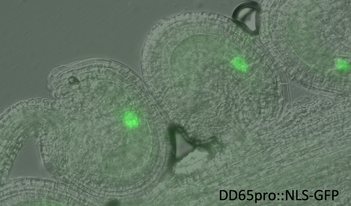Patterning the Female Gametophyte in Arabidopsis
 GFP marks the central cell nucleus
GFP marks the central cell nucleus
Funding: United States Department of Agriculture & National Science Foundation
The flowering plants that dominate our landscapes and agriculture alternate between a diploid sporophytic stage, which constitutes the main body of the plant, and a reduced, haploid gametophytic stage contained within the male and female floral organs.
Development of the female gametophyte, also known as the embryo sac, is crucial for plant reproduction and seed formation. In most flowering plants (including Arabidopsis), the haploid product of meiosis (the functional megaspore) undergoes three rounds of mitotic divisions, two of these cells are gametes: the egg and the central cell. Each of these is fertilized and develops into the embryo and endosperm respectively.
The gene CYTOKININ INSENSITIVE 1 (CKI1) is a key factor regulating differentiation and is required in particular for development of the central cell and antipodal cells. We are investigating the role and regulation of CKI1 including both upstream regulators and downstream targets. Because of the key role of the embryo sac in reproduction, a deeper understanding of the female gametophyte can yield potential applications towards the control of reproduction and seed production in crop plants.
The flowering plants that dominate our landscapes and agriculture alternate between a diploid sporophytic stage, which constitutes the main body of the plant, and a reduced, haploid gametophytic stage contained within the male and female floral organs.
Development of the female gametophyte, also known as the embryo sac, is crucial for plant reproduction and seed formation. In most flowering plants (including Arabidopsis), the haploid product of meiosis (the functional megaspore) undergoes three rounds of mitotic divisions, two of these cells are gametes: the egg and the central cell. Each of these is fertilized and develops into the embryo and endosperm respectively.
The gene CYTOKININ INSENSITIVE 1 (CKI1) is a key factor regulating differentiation and is required in particular for development of the central cell and antipodal cells. We are investigating the role and regulation of CKI1 including both upstream regulators and downstream targets. Because of the key role of the embryo sac in reproduction, a deeper understanding of the female gametophyte can yield potential applications towards the control of reproduction and seed production in crop plants.
